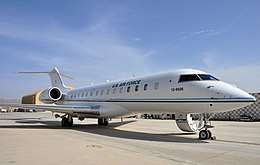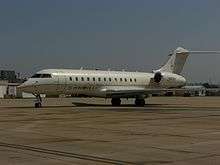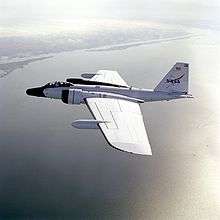Battlefield Airborne Communications Node
The Battlefield Airborne Communications Node (BACN) is a United States Air Force (USAF) airborne communications relay and gateway system carried by the unmanned EQ-4B and the manned Bombardier E-11A aircraft. BACN enables real-time information flow across the battlespace between similar and dissimilar tactical data link and voice systems through relay, bridging, and data translation in line-of-sight and beyond-line-of-sight situations.[1] Its ability to translate between dissimilar communications systems allows them to interoperate without modification.

Because of its flexible deployment options and ability to operate at high altitudes, BACN can enable air and surface forces to overcome communications difficulties caused by mountains, other rough terrain, or distance. BACN provides critical information to all operational echelons and increases situational awareness by correlating tactical and operational air and ground pictures. For example, an Army unit on the ground currently sees a different picture than an aircrew, but with BACN, both can see the same picture.
On 22 February 2010, the Air Force and Northrop Grumman BACN Team received the 2010 Network Centric Warfare Award from the Institute for Defense and Government Advancement.[2]
On 27 January 2020, USAF E-11A, serial 11-9358,[3] crashed in Afghanistan at about 1:00 PM (LT); 8:30 AM (UTC).
Purpose
Individual tactical data links (e.g., Link 16, EPLRS, etc...) are just a part of the larger tactical data link network, encompassing tactical data links, common data links, and weapon data links. Most military platforms or units are equipped with a tactical data link capability tailored to their individual missions. Those tactical data link capabilities are not necessarily interoperable with one another, preventing the digital exchange of information between military units. BACN acts as a universal translator, or gateway, that makes the tactical data links work with one another.
BACN also serves as an airborne repeater, connecting tactical data link equipped military units that are not within line of sight of one another.
An operational example would be:
- A B-1 flying an orbit on one side of a mountain range needs to communicate with a Tactical Air Control Party located in a valley on the opposite side of the mountain.
- The mountain prevents line-of-sight voice and data communication
- A BACN flying an orbit over the mountain range would act as an airborne communications repeater and TDL gateway connecting the two units
- The TACP can digitally send targeting information to the B-1 cockpit and communicate via the BACN aircraft
- The two units are able to communicate in near-real time without requiring limited SATCOM resources or other bandwidth constrained beyond-line-of-sight methods
Background

Interoperability between airborne networking waveforms has been a persistent challenge. There have been multiple systems developed to address the challenge to include Air Defense Systems Integrator (ADSI),[4] Gateway Manager,[5] and Joint Range Extension (JRE)[6] product lines. However, those product lines were separately funded/maintained and had interoperability concerns of their own.[7] The solution was an "Objective Gateway" which would serve as a Universal Translator to make data from one network interoperable with another.[8]
In 2005, the USAF's AFC2ISRC and ESC created BACN as an Objective Gateway technology demonstrator to provide voice and data interoperability between aircraft in a single battle area. The four key principles were
- radio agnostic - it would support a variety of communication protocols
- platform agnostic - BACN could be mounted on a variety of aircraft
- un-tethered - unlike previous repeaters, which were hung from floating aerostats, BACN has the ability to move within the battlespace
- Knowledge-based intelligence - the ability to sense waveform characteristics of sender and receiver and automatically route traffic.
The BACN first flight was November 2005 at MCAS Miramar in San Diego, CA.[9]
BACN was successfully demonstrated in Joint Expeditionary Force eXperiment (JEFX) 2006 and JEFX 2008 and selected for field deployment.[8][10]
Joint support
Getting critical air support to troops in contact with the enemy supports our troops on the ground, as well as in the air.
This project is not just limited to combat operations. It has provided the World Food convoy commander with “comms-on-the-move.” This capability allows convoys to stay in continuous contact with air support and around command channels in the complex, adverse terrain, mitigating exposure to attacks- they no longer needed to halt to establish communications.
Platforms

The BACN prototype was originally developed and tested in 2005-2008 on the NASA WB-57 high altitude test aircraft during Joint Expeditionary Force Experiments and other experimentation venues. The last two flying WB-57s were used for this mission in Afghanistan.[11]
BACN was also deployed for testing on a Bombardier Global Express BD-700 and originally designated as the RC-700A under a reconnaissance classification. The aircraft was later re-designated as the E-11A under the special electronics installation category.[12] The BD-700 was selected due to its high service ceiling (up to 51,000 ft) and long flight duration (up to 12 hours). These flight characteristics are critical in providing unified datalink and voice networks in the mountainous terrain encountered in the current theater of operations.
Additional E-11As have been deployed to increase availability and flexibility. These have been used in operations in Afghanistan.[13]
BACN payloads have also been developed, installed, and operated on special variant EQ-4B Global Hawk aircraft to provide unmanned long endurance high altitude communications coverage. The combination of BACN payloads on E-11A and EQ-4 aircraft gives planners and operators flexibility to adapt to mission needs and increase coverage in the battlespace to near 24/7 operations.[14] The effectiveness of BACN has increased the demand for more EQ-4B Global Hawk aircraft to be created and installed with BACN to be utilized in the field.[15] The BACN system continues to be a high in-demand system that the Air Force will more than likely continue to use for many years to come.
Northrop Grumman has also developed BACN pods that can be temporarily mounted to other various aircraft.[16]
BACN as a concept
BACN has been a controversial program within the DoD. This is caused by a number of issues including the personality clashes between the service people who conceived the project back in late 2004 and the traditional acquisition bureaucracy. This was particularly true between requirements developers at the former Air Force Command and Control Intelligence, Surveillance, Reconnaissance Center at Langley AFB, Virginia and their acquisition partners at the Electronic Systems Center (ESC) at Hanscom AFB, Massachusetts, part of Air Force Materiel Command.
BACN divides military planners and acquisition bureaucrats on two main fronts. First, how will an "Airborne Network" evolve beyond the existing tactical data links on today's platforms. Second, the BACN effort presupposes that the capability will initially be "outsourced" to commercial companies that will provide an "airborne network" as a service to the DOD for the foreseeable future.
The evolution of airborne networking
With few exceptions, today's military aircraft, in any service, are not networked. While many platforms have implemented tactical data links that allow some measure of collaboration between flights of aircraft, very little information is passed between command and control elements and attack aircraft at the tactical edge. Since 2001, the DoD has made significant progress in "linking" platforms together. This would include some degree of cross service interoperability but within common groupings like ground attack aircraft and fighters. USAF F-15s and US Navy F/A-18s can link together using Link 16 and share some limited information between flights like target data, fuel and weapons status. On the other hand, USAF bombers like the B-52 and B-1 are not equipped with data links and cannot interoperate with either F-15s and F/A-18s. Furthermore, half the USAF A-10 and F-16 fighter force in the Air National Guard (ANG) are equipped with Situational Awareness Data Link (SADL)[17] gear that cannot interoperate with Link 16 unless there is a "gateway" which has radios for both data links, and a computer system that can interconnect them and translate the data. While the deployment of data links to fighter aircraft has aided flights of aircraft to coordinate their attacks locally, these systems are constrained by line of sight and cannot reach command and control centers that are often hundreds, if not thousands, of miles distant from where the fighting is taking place. While the USAF has taken the lead to field "gateways" that can handle both connecting dissimilar links and relaying data over satellite back and forth to connect command and control to the tactical edge, the platform that carries the gateway is more often than not dedicated to another mission (like air refueling) that consumes limited resources and sub-optimizes some other critical theater activity.
There are unfortunately bigger problems with linking aircraft together with data links. While ground attack aircraft are increasingly linked, they cannot interoperate with attack helicopters or ground forces with any service. In an age where there is zero tolerance for even a single "friendly fire" death, attack aircraft from either the Navy, Marine Corps or the Air Force use the same sensors to prevent fratricide that were used in World War I—their eyeballs.
Late in the last decade of the Twentieth Century, defense planners began to think beyond simply "linking" forces to "networking" them and fundamentally changing the information model at the tactical edge from one that required a priori knowledge of required information to employ forces, or "push" model, to one in which the information required was globally available and could be "pulled" as required by warfighters engaged in combat. This new model came to be known as "Network Centric Warfare (NCW)."
The drive towards NCW began in earnest with the arrival of the Bush Administration. Former Defense Secretary Donald Rumsfeld drove a transformation of the DoD so that it would be capable of meeting the needs of the 21st century. This DoD-sanctioned technology push became the perfect incubator for pursuing a networked force. On Rumsfeld's recommendation, President Bush appointed a number of industry leaders to key positions within the DoD that brought with them their experience in the technology revolution that exploded in the 1990s.
The concept is expected to evolve into the Joint Aerial Layer Network.[18][19][20][21][22]
Finally, with the increasing likelihood of a contested electromagnetic spectrum (EMS) in an era of great power competition, the idea of a "BACN-mesh" was proposed by Professor Jahara Matisek (and former E-11 BACN pilot) at the US Air Force Academy, as a way of pursuing new multi-domain war-fighting options against near-peers. Specifically, Prof. Matisek suggests that smart node pods (i.e. a BACN-light payloads affixed to aircraft with hardpoints), could provided layered BACN “bridging” connections and TDL services to war-fighters in an EMS-contested battlespace, without deploying a specific BACN aircraft. For example, in the Pacific – where infrastructure is limited – a “BACN-mesh” concept could be employed to create real-time battlespace pictures, proving useful when a near-peer adversary attempts localized jamming across the EMS. A "BACN-mesh" concept, if properly employed with numerous smart node equipped aircraft, would "create a complex, impregnable, and mutually reinforcing communication network with multiple relay nodes."[23]
References
- "The Official Home Page of the U.S. Air Force". af.mil. Archived from the original on 22 April 2012. Retrieved 5 September 2015.
- "Northrop Grumman Airborne Communications System Wins Award for Outstanding Industry Achievement (NYSE:NOC)". irconnect.com. Retrieved 5 September 2015.
- http://www.joebaugher.com/usaf_serials/2011.html
- "Ultra Electronics Advanced Tactical Systems : Products : Air Defense Systems Integrator". ultra-ats.com. Retrieved 5 September 2015.
- "Gateway Manager". Northrop Grumman. Retrieved 5 September 2015.
- "Joint Range Extension JRE". jre-gw.com. Retrieved 5 September 2015.
- "DEPARTMENT OF THE AIR FORCE FISCAL YEAR (FY) 2005 BUDGET ESTIMATES : RESEARCH, DEVELOPMENT, TEST AND EVALUATION (RDT&E) DESCRIPTIVE SUMMARIES, VOLUME II" (PDF). Saffm.hq.af.mil. Archived from the original (PDF) on 2007-10-15. Retrieved 2015-09-06.
- "C4ISTAR: ENABLING WARFIGHTERS" (PDF). Rusi.org. Archived from the original (PDF) on 2007-10-12. Retrieved 2015-09-06.
- Battlefield Airborne Communications Node Spiral 1 First Flight. YouTube. 31 May 2012. Retrieved 5 September 2015.
- Archived August 11, 2011, at the Wayback Machine
- Andrew Tarantola. "Why Are the Most Vital Aircraft in the USAF Arsenal Owned by NASA?". Gizmodo. Gawker Media. Retrieved 5 September 2015.
- "U.S. Air Force Officially Designates Aircraft Flying Battlefield Airborne Communications Node System". irconnect.com. Retrieved 5 September 2015.
- "The Aviationist » U.S. airborne communication plane could be tracked on the Web for 9 hours during air strike that killed Taliban leaders in Afghanistan". The Aviationist. Retrieved 5 September 2015.
- "Two More Global Hawks to Receive BACN Coms Gateways." Defense Update, 1 February 2012.
- "More BACN, Please. Data Node for Global Hawks in High Demand". Defensetech. 2017-07-06. Retrieved 2017-10-03.
- "Smart Node Pod" (PDF). Northropgrumman.com. Retrieved 2015-09-06.
- "Tactical communications group adds situational awareness data link SADL capabilities to its tactical data link communications solutions", G2TCG.
- Archived October 24, 2013, at the Wayback Machine
- Seffers, George I. (2013-06-01). "Joint Aerial Layer Network Vision Moves Toward Reality | SIGNAL Magazine". Afcea.org. Archived from the original on 2015-09-30. Retrieved 2015-09-06.
- "Colonel discusses vision of joint aerial layer network". af.mil. Archived from the original on 14 February 2013. Retrieved 5 September 2015.
- Archived March 2, 2013, at the Wayback Machine
- "All U.S. Aircraft Could Talk to Each Other, Someday". DoD Buzz. Retrieved 5 September 2015.
- Matisek, Jahara (24 June 2020). "Communications in Multi-Domain Operations: What Does the BACN Bring?". OTH Journal.